Letter Bombs
Gerhard Zucker’s rocket post
Christopher Turner
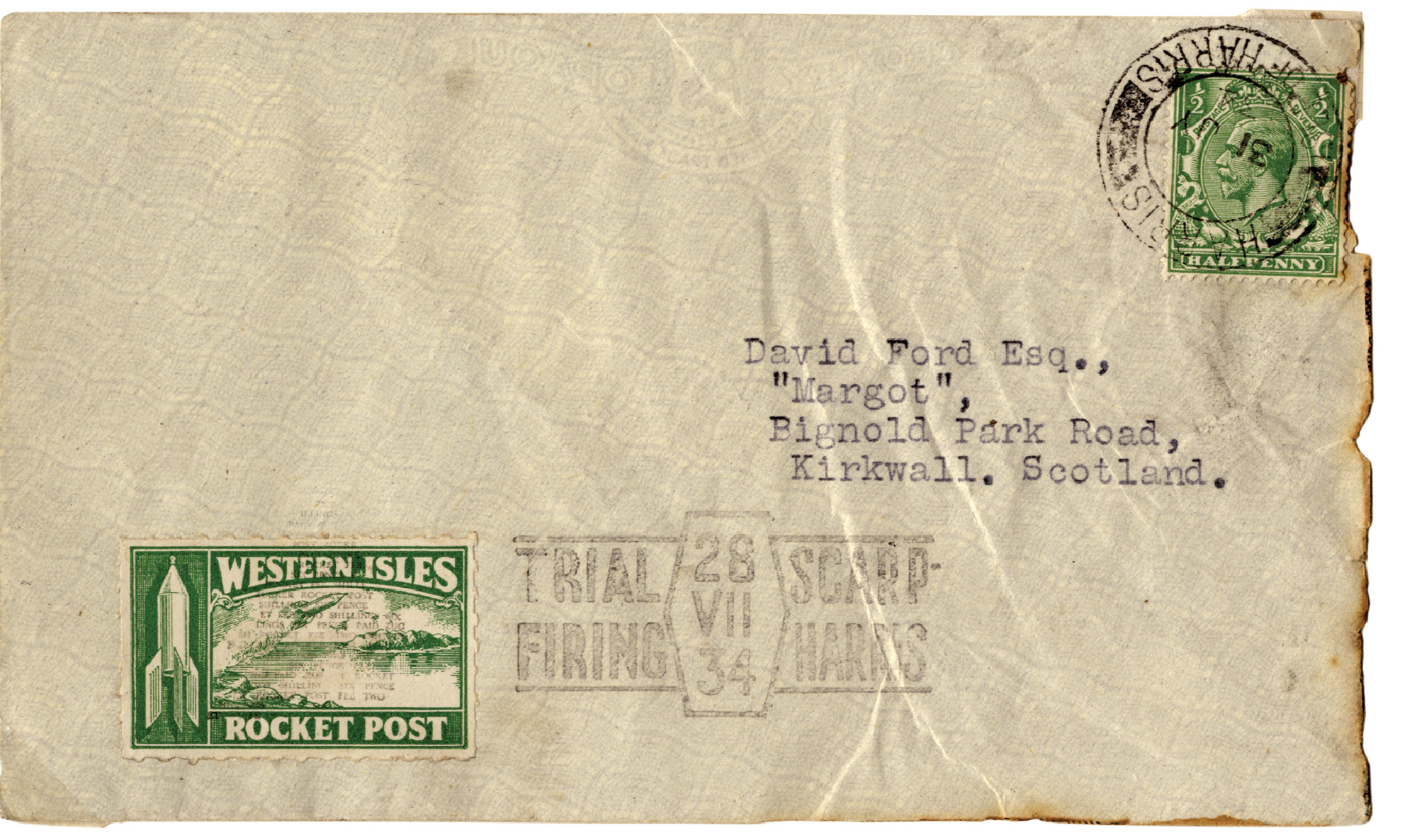
There is a picture of Gerhard Zucker, taken in Berlin in 1933, which shows him demonstrating a model of his thirteen-foot rocket to a large crowd of Nazi officials; he boasted then that it was “the largest rocket ever built on earth.” The twenty-five-year-old inventor is gesturing towards his “dirigible air torpedo,” which lies on a carriage with flimsy wheels and points forty-five degrees into the air. The Luftwaffe had been disbanded under the Versailles agreement, and Zucker was explaining to the assembled representatives that his missile might reach many parts of the world as an alternative bomb carrier. He wanted 10,000 DM to develop his idea.
In the background of this photograph you can see a group of jodhpur-clad Brown-shirts laughing. Of the fourteen specialists in attendance, twelve declared Zucker’s idea utopian—only two, Zucker later remembered, believed it might work. In a three-page curriculum vitae, written shortly before his death in 1985, Zucker wrote that after this lecture he was taken to a lunatic asylum for a psychiatric evaluation. He described how he was locked up for two hours—“the doors had no handles on the inside!”—before a friendly psychiatrist declared him sane. The doctor, Zucker later claimed, “suggested I should send those who had sent me for tests.”
What Zucker didn’t know was that the Nazis had already begun secret experiments with early liquid fuel rockets. The previous summer, twenty-two-year-old Wernher von Braun, a member of the Jules Verne–inspired Society for Spaceflight (VfR), had impressed officers of the German Army Ordinance by successfully firing a rocket 1,000 feet into the air. Early rockets were notoriously inefficient and erratic—a dangerous hobby for the young men who gathered just outside Berlin on a patch of scrubland known as Rocket Airfield (rocket pioneer Reinhold Trilling died the year of Zucker’s demonstration in a laboratory explosion which also killed his two assistants). The Nazis established the Peenemünde Rocket Center on the Baltic Sea to perfect the science, where over the next decade von Braun and a growing team of specialists would develop the famous V-2 rocket, 3,500 of which would be launched in World War II.
In 1933, Zucker worked in the mountain town of Silberhutte for Eisfeld, a company that had developed a rocket-propelled train that Zucker—prone to self-mythologizing—claimed to have driven as it was sent hurtling along its rails at 250 kilometers an hour. “I was virtually the first rocket pilot, but earned no appraisal at that time,” Zucker boasted. “I realized then that rockets had no place on the earth’s surface, but would be more suitable to fly” (Max Valier, author of “Berlin to New York in One Hour” and also a member of the VfR, was in fact the first rocket pilot. Valier died when his rocket car exploded in 1930).
Having been rejected by the army, and determined to get his rocket airborne, Zucker persuaded his father, who owned a dairy in the Harz mountains, to sell a few acres of land to fund his craze for rocketry. His subsequent experiments with rockets were media events, and Zucker’s natural talent for showmanship became an embarrassment to the Nazis, who feared he would draw attention to their own secret tests. They tried, and failed, to stop him flying rockets. It is later thought that he must have redeemed himself: some historians believe that he joined von Braun’s team in the late 1930s.
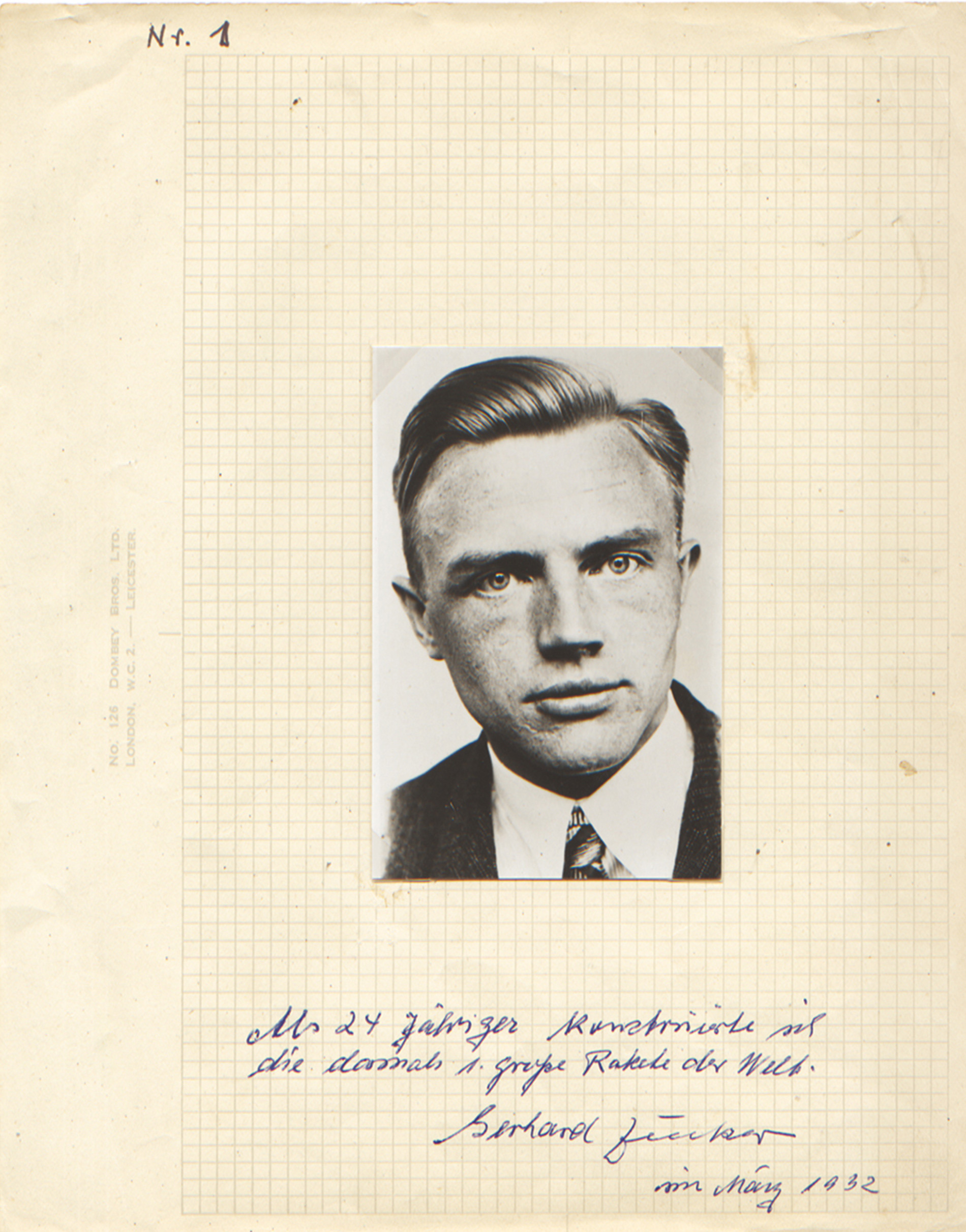
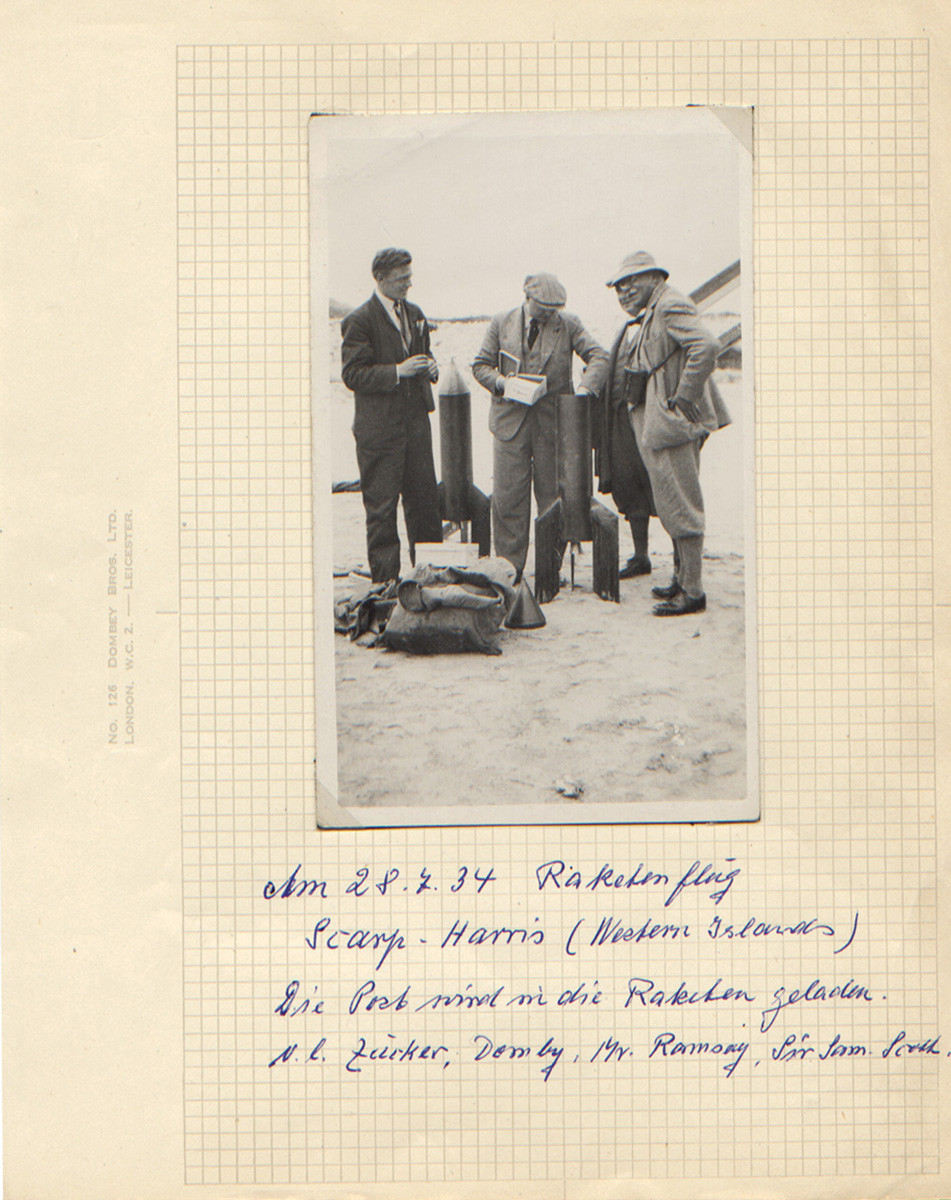
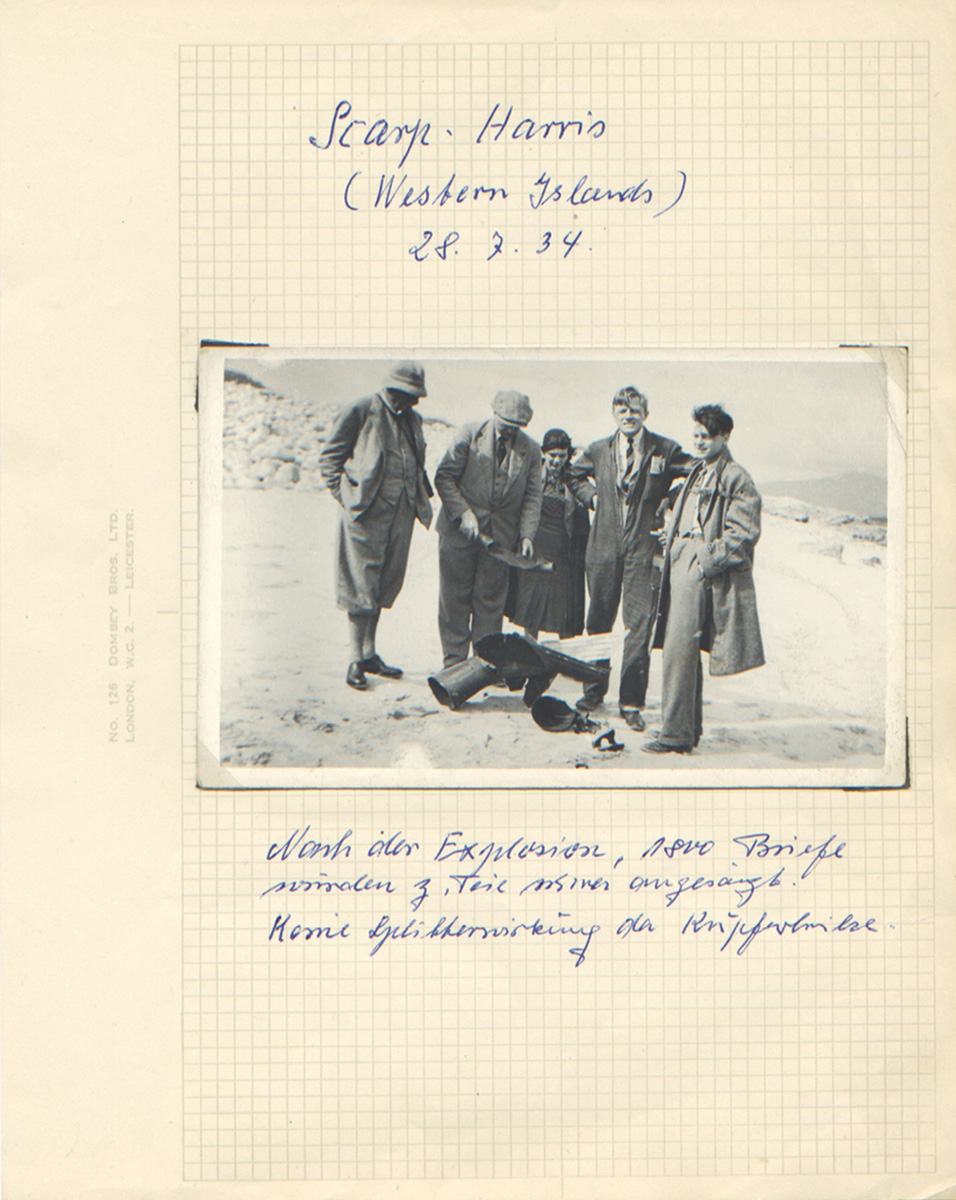
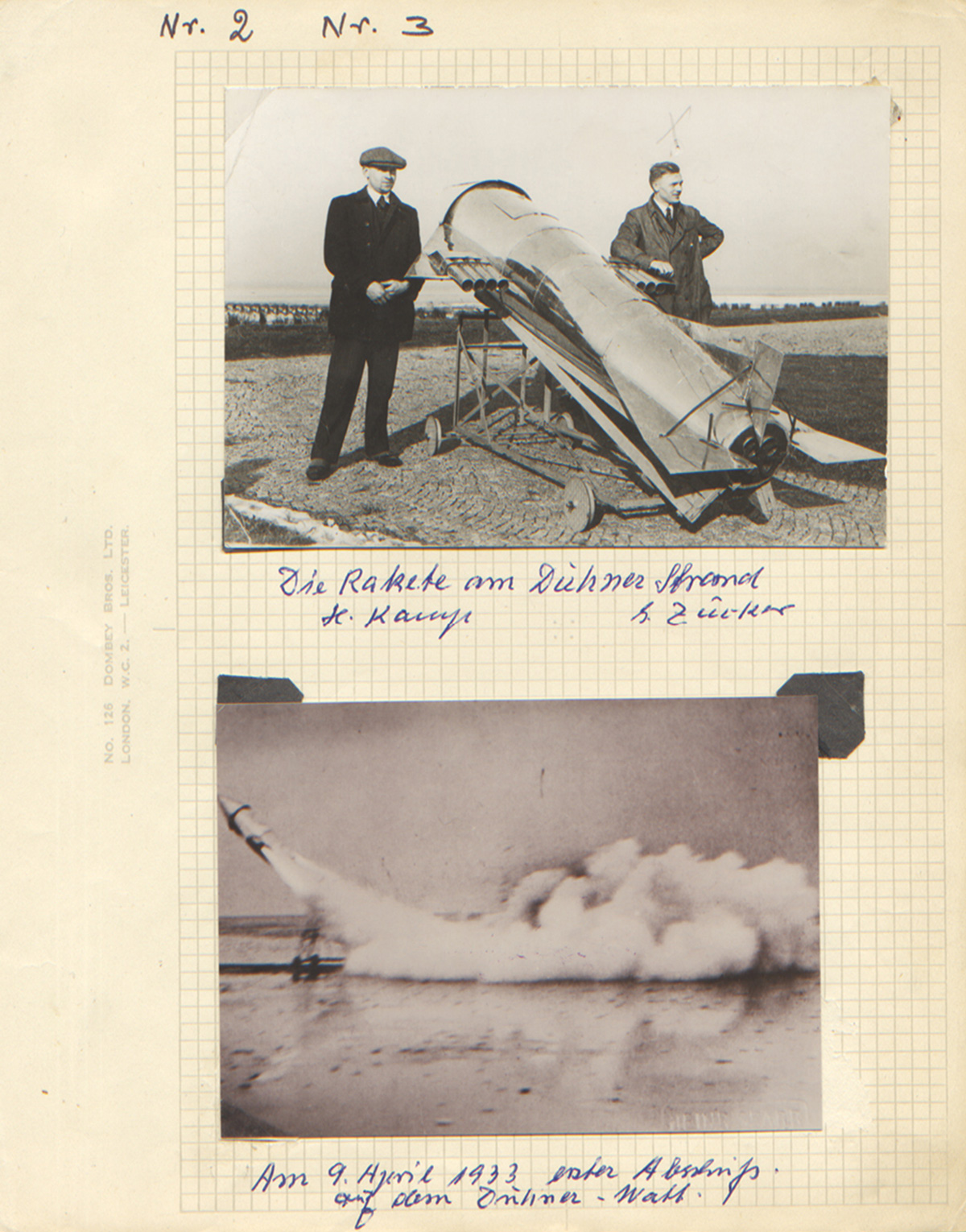
Zucker fired his first missile on 9 April 1933, near Duhnen on the North Sea coast. According to one contemporary journalist, the large crowd who turned out to watch burst out in mocking laughter when his rocket belly-flopped into the Cuxhaven mudflats. Zucker blamed the ballistics experts who supervised his experiment and demanded that he reduce the amount of igniter fuel by half—Zucker had packed enough, they said, to propel his rocket to Helgoland, seventy kilometers off the German coastline. Zucker planned another flight four days later—which would carry a mailbag of postcards that had been stamped with the message “Sent by the dirigible mail-rocket Herta (System Zucker)”—but the authorities forbade him from making any further demonstrations.
Zucker’s obsession wasn’t so easily extinguished by Nazi officialdom. In the summer of 1934, he accepted an invitation to the APEX International Airmail Exhibition in London. The organizers had initially invited Friedrich Schmiedl, the Austrian rocketeer who had made the first rocket mail flight in 1931, and who had planned a regular service over the Alps between Germany and Switzerland. But Schmiedl had destroyed all his scientific instruments and special apparatus in 1933, so as “to prevent their misuse for military purposes.” Zucker, who would have been delighted to have won the military backing awarded von Braun, had no such reservations.
At the exhibition, Zucker’s fortunes changed when he met the London stamp dealer C. H. Dombrowski, with whom he became joint founder and co-director of the British Rocket Syndicate. “All that I was refused in Germany,” Zucker wrote, “I was to become in London.” According to Zucker, Dombrowski raised £50,000 for future flights, a sum which he hoped to recoup by selling specially minted rocket mail stamps. “If successful, the stamps will be very valuable,” Zucker told potential sponsors. “Some stamps sold in Germany three months previously are now worth £100.” (The stamps from his aborted Duhnen flight were selling for 800 times their original value.)
The logician and philosopher, Robert Hartman (who was nominated for the Nobel Peace Prize in 1973), then working as a photographer in London, volunteered to become the syndicate’s press agent. In his autobiography, Freedom to Live, Hartman recalled meeting the persuasive Zucker:
On a routine photographic trip to the opening of the London Air Post Exhibition, I met Gerhard Zucker, a young German … who had invented a rocket, the forerunner of the lethal German V-2 rockets of World War II and of the rockets of today which are taking man into space. Zucker wanted his rocket to be used to carry mail. Hitler, he said, had wanted to use the rocket to deliver bombs, and he wouldn’t go along with that, so he got out of the country … I liked the guy, and he liked me, and I agreed to serve as his publicity man.
Zucker was shrewd enough to hide his attempted collaboration with the Nazis from Hartman, who was Jewish and vehemently anti-fascist. Hartman had waged a brave print campaign against Hitler, and when the Nazis came to power he narrowly escaped arrest by hiding in an insane asylum until his friends could smuggle him out of Germany. In contrast, Zucker’s alleged pacifism was more accidental than principled.
The newly formed British Rocket Syndicate immediately encountered a major obstacle. When Zucker telegraphed the German firm who made and packed his special rocket fuel, he discovered that the Nazis had banned its export. Mrs. Dombrowski was dispatched on a special trip to Germany to buy a supply—it was planned that she would sneak some back hidden in her hatbox. However, she soon realized that the Gestapo had her under close surveillance and came back empty-handed. Zucker was forced to rebuild his aluminum rocket to accommodate substitute cartridges packed with British Brocks Firework powder instead.
At dawn on 6 June 1934, Zucker assembled his launching rack on the Sussex Downs and lubricated its rails with butter. At three feet six inches, the rocket that was loaded onto it was a miniature version of the one used at Dunhen. There were only six witnesses to the test flight—Zucker, Dombrowski, Hartman, a philatelic magazine editor, and a reporter and a photographer from the Daily Express, to whom Hartman had sold the exclusive rights to the story. Dombrowski had designed special rocket stamps, which featured Zucker’s rocket hurtling over the goalposts of London’s Tower Bridge.
Zucker pressed the trigger—“And, by golly, it worked!” wrote Hartman. The shiny aluminum rocket was then filled with letters and it flew perfectly twice more, tracing a neat curve, reaching heights of 800 meters, and covering distances of up to a mile. A thousand letters, postmarked “Zucker Rocket Post, Rocket fee two shillings sixpence paid,” were flown; Zucker addressed one to King George V. The recipients must have thought they had traveled via the moon, but in fact they were taken to Brighton Post Office, having only been airborne for several seconds, and made the rest of their journey by conventional mail. (The London Evening News had been cynical about the chances of the letters making it to their destination: “If the rocket misses fire,” a journalist for the paper wrote, “the letters will no doubt be given to the village idiot to take to the post-office.”)
The next day, the Daily Express featured the front- page headline, “FIRST BRITISH ROCKET MAIL,” and the subheading, “Syndicate Plans 1-Minute Postal Service Between Dover and Calais.” Zucker apparently hoped for a regular service across the twenty-one-mile English channel; he thought his rival Friedrich Schmiedl might be persuaded to operate a seventeen-foot version of his rocket from the French side of the channel, whilst he would return fire from England.
One can only imagine Goebbels, who was aware that the capital was a potential target for the V-2, getting excited when he read another news story about the “German rocket flight over London” (the author had evidently taken the image used on Dombrowski’s stamp literally). The British government also became interested in Zucker’s scheme, and that July they arranged for an official test flight in Scotland. It was the first over-water rocket flight ever attempted, from Scarp Island to the Isle of Harris just under a mile away.
This remote part of the Hebrides had been in the news recently because the people of Scarp, which had no telephones, were unable to contact anyone in an emergency when bad weather made it impossible to relay a message by boat. Christina Maclennan, who was due to have twins, had a difficult labor and no doctor could be summoned to help her; she eventually had one daughter on Scarp and the second, after the weather had died down and she could be evacuated, two days later in a hospital on the Isle of Lewis. The mother and twins survived, but questions were asked in the House of Parliament about how the great British Empire could allow its own subjects to live with such primitive communications. Zucker’s rocket, a high-tech emergency flare, promised to provide almost instant messages.
His thirty-pound air torpedo was intended to zoom at 1,000 miles per hour across the Sound of Scarp. However, when the much-anticipated launch took place, the rocket lifted only a few feet before exploding with a dull thud. When the smoke cleared, 1,200 letters marked with green and red rocket mail stamps could be seen falling like confetti over the beach. Seven hundred and ninety-three envelopes were salvaged, and their singed remains were posted anyway, stamped with the three-line disclaimer “Damaged by first / explosions at / Scarp-Harris”; the scorched markings only increased their value for collectors. According to one witness, “the rocket was split open and twisted out of all recognition.” Zucker blamed his makeshift propellant, claiming that he needed his special German fuel. “It was the cartridge,” Zucker explained. “The powder had not been properly packed and air pockets caused the explosion.”
Another attempt was made three days later in the opposite direction, from Harris to Scarp, but it too met with failure. “There was a flash of fire,” the Scotsman reported, “a cloud of smoke, and when the air cleared the letters were seen strewn about the wreckage of the firing apparatus.” It was small consolation that a piece of the rocket managed to hit its intended target.
“With German stubbornness,” as Hartman put it, Zucker “plodded on.” In the winter of 1934, the London Evening News dubbed him the “try-try-again inventor” after he announced his plan to send a rocket from Lymington golf course in Hampshire across the sea to the Isle of Wight. Zucker had made adjustments to his rocket and it launched successfully, speeding away on its ten-second journey with a fierce hiss. However, a southerly gust of wind blew it off course, keeping it to the mainland, and the rocket was found badly buckled, buried three feet deep in the mud of Pennington Marshes a few miles away.
Freeman Dyson, the distinguished English-born American physicist—who worked on the clandestine development of a US nuclear-propelled “atomic spaceship” between 1957 and 1965 (known as Project Orion)—grew up in Hampshire and was a ten-year-old eyewitness to the launch. “They had this very impressive-looking rocket,” Dyson remembers:
They set it up with great ceremony on this rather derelict piece of land where we lived, which was sort of a mudflat on the coast opposite the Isle of Wight. They had some dignitaries from London who came down, and ceremoniously put this bag of mail with special stamps into the rocket. Then they launched and the thing zoomed up into the sky very beautifully. But then it turned around and came back almost exactly where it took off and landed with a big splash in the mud. So they went out and retrieved it and the mail went over later on the boat.
The Home Office tried to stop this boomeranging flight, and had advised Zucker to try out his rocket in the safety of an artillery range or at sea. The Postmaster General was admonished by the Secretary of State for sending two of his representatives to witness the Lymington launch—“You will appreciate that these apparent indications of official encouragement have been a little embarrassing to us, and to the Police, in our attempts to prevent what we regard as a distinctly risky experiment.” As the Rt. Hon Sir Philip Sassoon, MP, put it when answering an enquiry about Zucker’s rockets from the Indian Air Mail Society (which went on to carry out 270 rocket mail flights between 1934 and 1944), “the ones tested have shown a remarkable tendency to convey letters to anywhere but their proper destination.”
Zucker was later arrested and spent two days in prison after leaving a dangerous load of gunpowder in a railway station cloakroom. Rumor spread that he was a Nazi spy who was scoping out potential U-boat ports and secretly trying to gauge the sophistication of British explosives. Zucker was deported from Britain soon afterwards, accused of defrauding the Post Office with his bogus stamps (the Post Office had the exclusive privilege of conveying letters) and of being a danger to the national security of the country (due more to the threat of injury his loose rockets posed than to the espionage he was wrongly thought to have been doing). In 1936, after a brief tour of Europe, he returned to Germany to see his parents and was immediately imprisoned by the Gestapo—charged, he later claimed, with high treason.
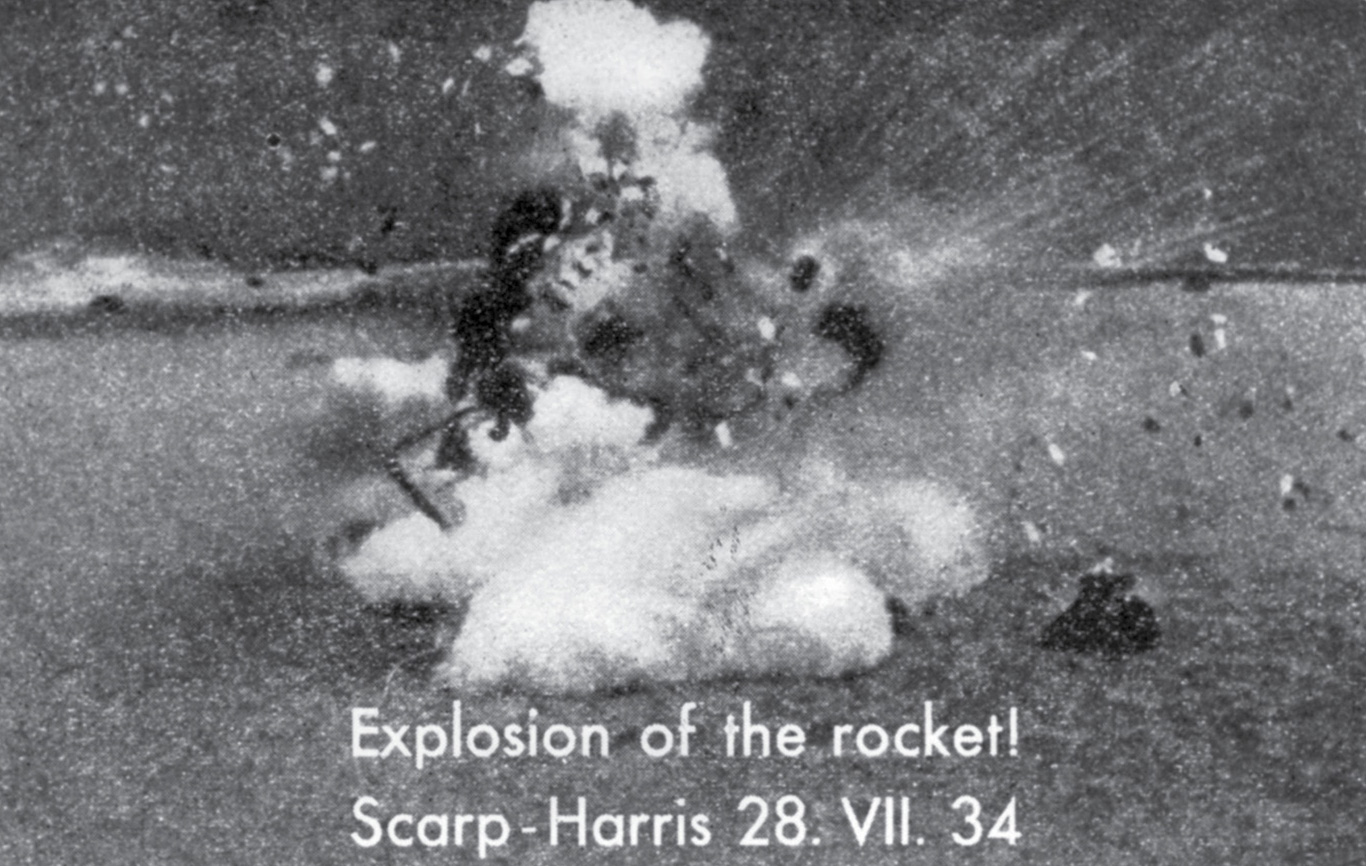
In his biography, Hartman wrote that he had read a notice in the Hamburg Fremdenblatt reporting that Zucker had been executed for “an attempt to sell an invention important to Germany to a foreign power.” But Zucker hadn’t been made “a head shorter,” as he later joked, because he could prove that a German subject, Hartman, had been at every launch. Hartman was in political exile, so it is unlikely the Nazis would have been impressed with Zucker’s citing him in his defense. And Hartman thought Zucker dead, and so was evidently never interviewed to clear his friend.
The Nazis obviously wouldn’t have been pleased that Zucker had alerted the British to the potential military uses of rockets. But was he really charged with treason? Newspaper cuttings tell a different story of Zucker’s fate. He served just under sixteen months in prison, they say, for fraud and embezzlement, accused of selling stamps from two rocket launches in Ostende, Belgium, that never took place. Zucker was freed, with one condition: that he never touch a rocket again.
He joined the Luftwaffe in World War II, but was so badly wounded in August 1944 that he was left, as he described it in his CV, “70% invalid.” The month after he was hospitalized, the first V-2 rocket was launched against Britain. It rose to a height of over fifty miles, and sketched a graceful parabola, before devastating Staveley Road in Chiswick, South London, over 200 miles from the launch site. Sixteen seconds later, another one-ton warhead left an enormous crater in the middle of Epping, just north of the capital. The rockets were built by inmates of the Dora concentration camp in the appalling conditions of the subterranean Mittelwerk assembly plant; it has been estimated that more people died manufacturing the V-2 than were killed by its blast.
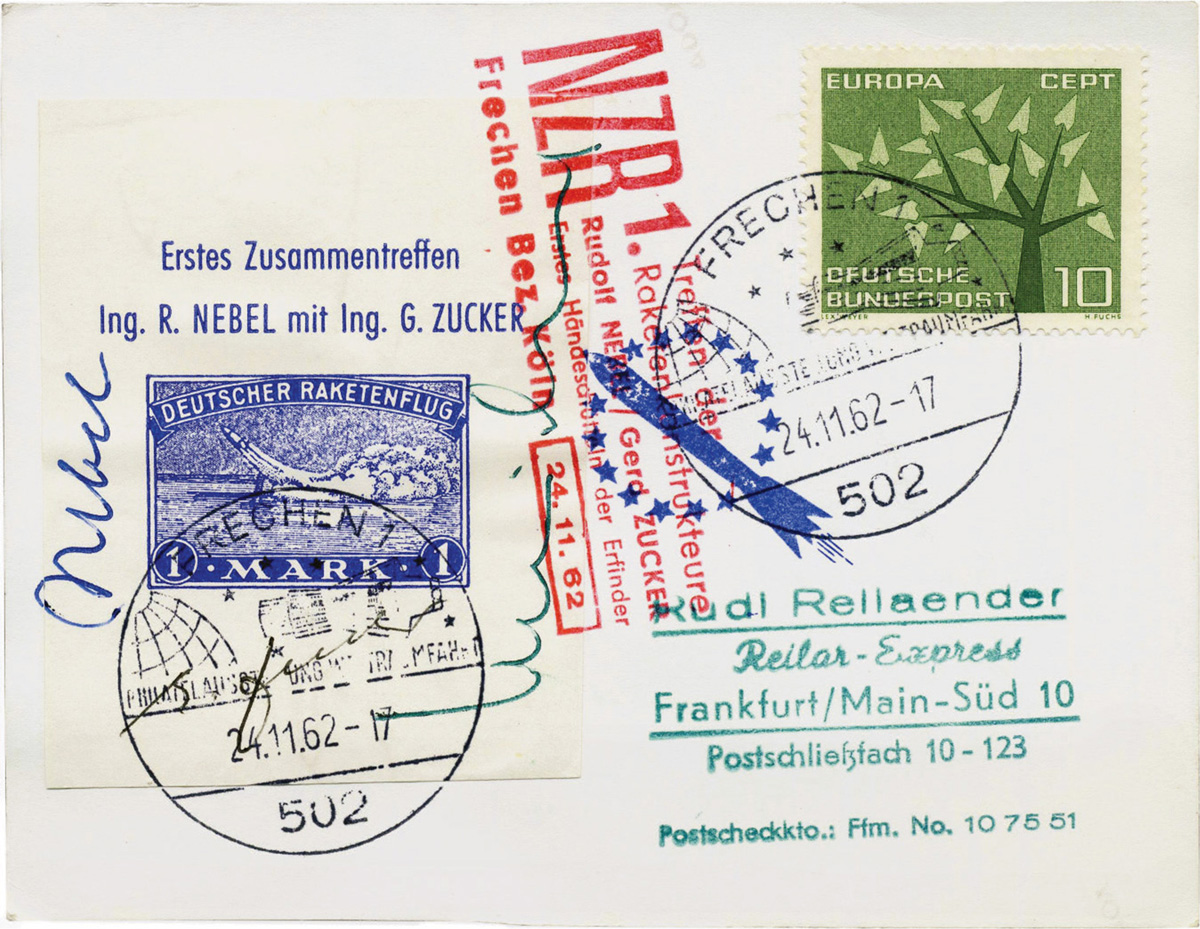
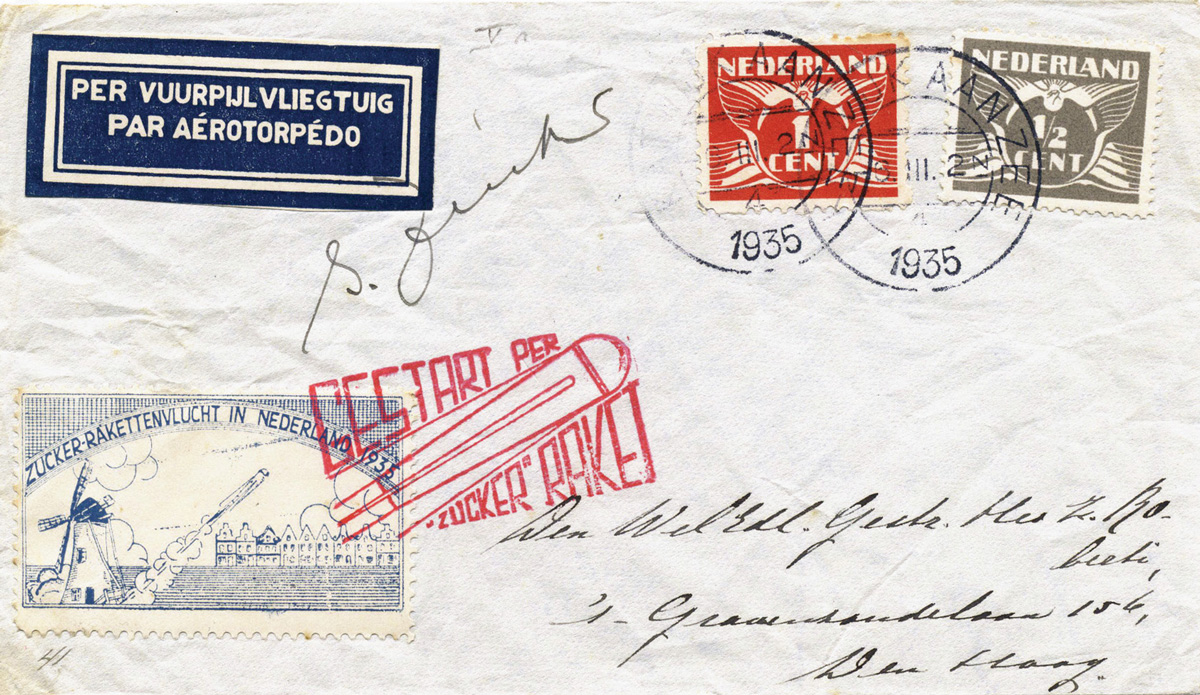
Zucker met his wife in the hospital where he sat out the war. He never worked for von Braun at Peenemünde, as it has been claimed. The Nazis thought him small fry, a careless enthusiast. After the war, von Braun and his team were secretly extricated to the United States— the Nazi scientists were too useful to the American military to be executed as war criminals—but Zucker was left behind to begin a new career as a furniture dealer in West Germany.
In the 1960s, Zucker once again began flying rocket mail. “This was just playing around,” he wrote in his CV. He failed to mention that on Ascension Day 1964, this “playing around” brought him into the headlines once again, when another of his rockets exploded, scattering shrapnel over the crowd of spectators and killing two schoolboys. Zucker served a six-month prison sentence for involuntary manslaughter—it was the third time rockets had landed him behind bars—and the West German government consequently banned all civil rocket experiments.
By then, his fantasy alter ego, von Braun, now director of the George C. Marshall Space Flight Center in Huntsville, Alabama, was developing the Saturn rockets that would launch man to the moon. Zucker wanted recognition for his tangential role in that amazing story. “I can see today that I was the first pioneer,” he wrote, concluding his sketch of his life. “Posterity may give thought to how difficult and dangerous it was. But only those who fought and those who have died in thought know. That was my life, the memories remain.”
A sound recording of one of Zucker’s (successful) rocket-mail launches is available at www.cabinetmagazine.org/issues/23/zucker.php.
Christopher Turner is an editor of Cabinet and is currently writing a book, Adventures in the Orgasmatron: How the Sexual Revolution Came to America, to be published by Farrar, Straus and Giroux.
Spotted an error? Email us at corrections at cabinetmagazine dot org.
If you’ve enjoyed the free articles that we offer on our site, please consider subscribing to our nonprofit magazine. You get twelve online issues and unlimited access to all our archives.